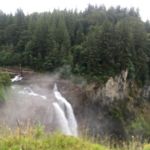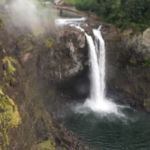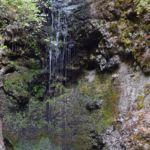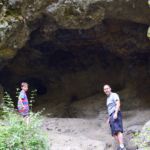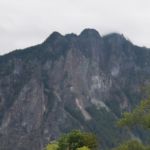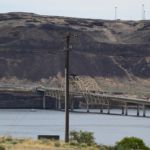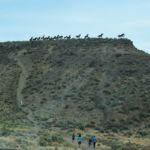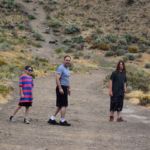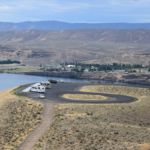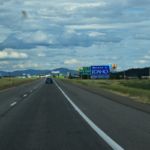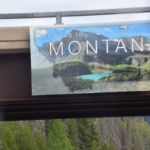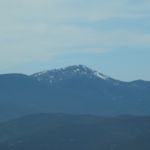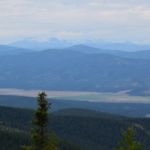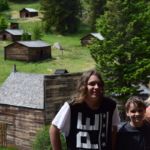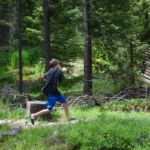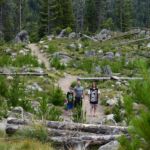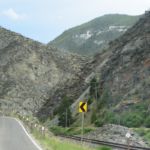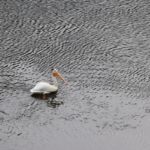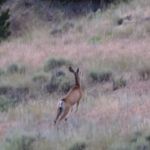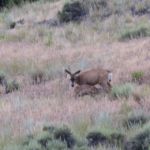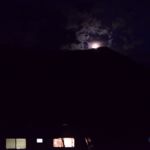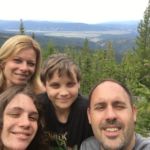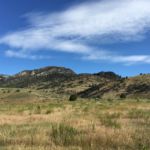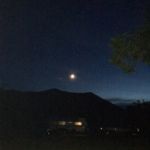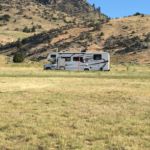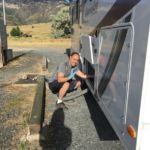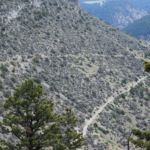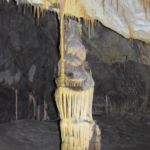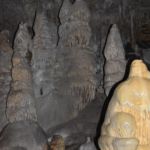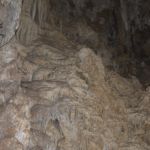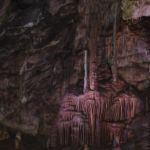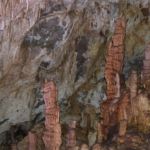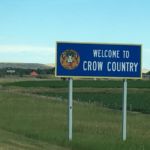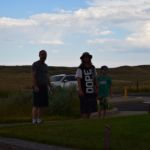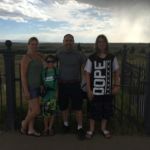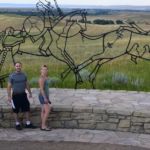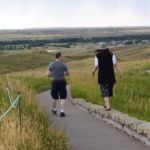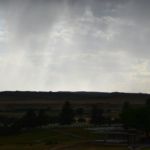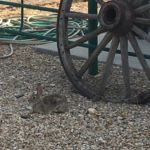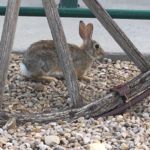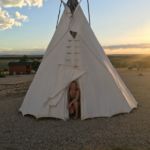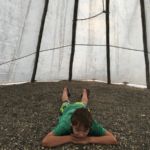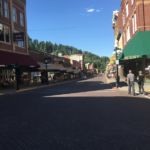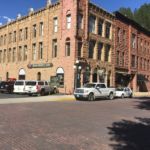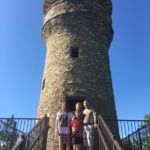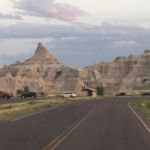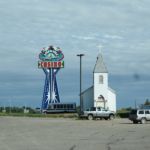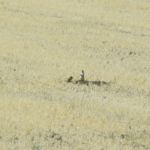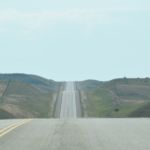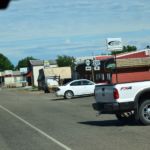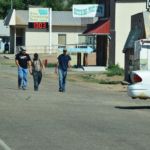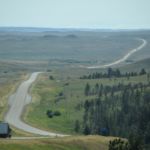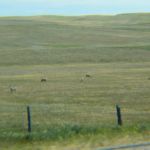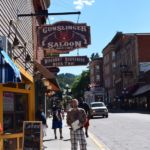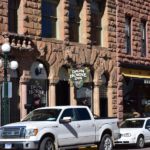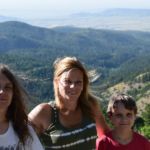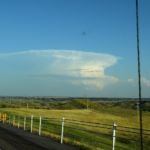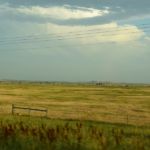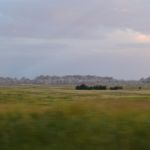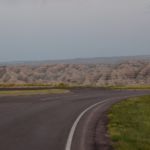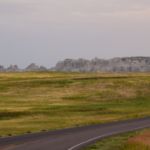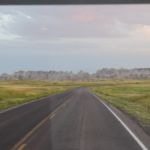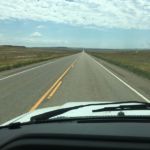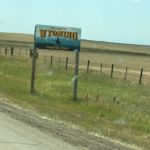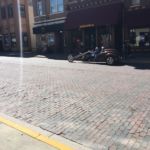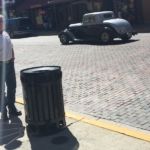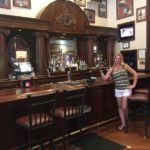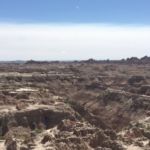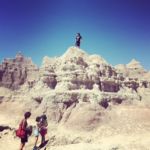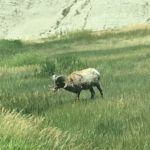When I made the plans for Day 3, I saw multiple warnings on the internet about making sure to get to Lewis & Clark Caverns early to get a ticket, because they can only be purchased on-site for THAT day, and they sell out fast. I had scheduled us to leave the campground at 8:30, before they opened at 9am. The tours are guided and take ~2 hours, so I gave us a 3 hours time slot for this event on the itinerary, to account for some wait time. Talking to the camp ranger at check-in, she corroborated my information, but said that nobody goes early, so if I were to be there promptly at 9am, I would assuredly be on the first tour. She was right.
It seems like campsite departure preparations go pretty quickly, but it does somehow take a significant amount of time. Even with the grill and chairs already stowed the night before, I had a few tasks. First, I had to drive the front wheels off the wood planks stepfather left in the truck for nights like this when one side or one end of the rig was lower than the other. (There are few things more annoying than the feeling of rolling downhill – and out – of bed all night long.) I also had to disconnect the electrical connection (once all the coffee and toast was made), put the picnic table back on the grass, pull down the privacy curtains, roll in the awning, roll in the slide-out, make sure all the side hatches, roof vents, and windows were closed and latched.
While I was making ready to leave, the rest of the family ate breakfast and secured all loose items. With my itinerary reviewed, map at hand, and printed directions ready (surprisingly, it’s been easier, almost every time, to use the old fashioned method than the GPS) we were ready to go. On this morning, since we’d had no water/sewar hookup the night before, our first stop was ALL THE WAY… on the other side of the street… to empty the black water tank (toilet waste) and grey water tank (sink & shower waste) and then add a little fresh water back into the black tank to stop odors. Oh, and I made sure we still added a little water to our fresh water tank, too, so we could flush the toilet, have a drink, wash a spoon, etc. while we were going down the road later in the day. I know it’s extra weight to pull around which might kill our gas mileage, but it IS vacation, right?
We left the dump (sewage) station at 8:50am and were 3 miles up the road at the ticket booth by about 5-after; wearing long pants and sweatshirts (49-50 degrees inside the cave at all times). We were one of the first vehicles into the parking lot, and easily secured a spot on the first tour at 9:20am (whew). The short wait gave us time to take in the landscape, as well as watch a mule deer fawn prance around its parents in the ravine below the parking lot. Perhaps it was the same 3 deer that Sean and I had seen the night before?
Passing the entrance to the tour, the guide takes a head count, and collects the information cards that were handed out with the tickets. Then, all the eager visitors proceed along the sidewalk that winds across the side of the hill/mountain to the mouth of the cave. I happened to notice, though, that the guide didn’t immediately proceed down the sidewalk with the group. Instead, he went back across the parking lot to return the information cards to the ticket booth. Mom and I waited for him – I figured he’d appreciate it, and I also thought maybe we’d get some private time and “bonus” information. The guide was named Jim, and he was a retired teacher in his 11th year as a guide (with over 3,000 trips inside). He explicitly thanked us for walking with him, because normally he does walk alone, like I suspected. I’m fairly certain we had a great conversation, too, but it’s hard to say for sure. Jim apparently has a habit of walking on the outside edge of the paved path. As you see from one of the pictures I’m attaching, the paths to and from the cave traverse the relatively steep face of the mountain. There is no railing, and although it’s a paved path, there are places where the edge drops so drastically that the pavement is jagged and dropping away itself. Jim’s 69 year old left foot landed so near the “open air part of the trail” that his ankle actually buckled a couple of times because only two-thirds of his left foot actually connected with anything solid. So we must have had a good conversation, but I know I spent the entire time trying to figure out how to adjust myself so that he’d get away from the edge. I tried hugging the inside of the path, and I even tried being just slightly ahead or behind him, but nothing made a difference. I started to get the idea that maybe Jim’s walked that trail so many times that he now plays a little game with himself. In the end, I have no idea what we talked about, but I do know that I kept looking down the slope under Jim’s left foot wondering if, when he falls off, will he stop rolling close enough to the trail where he’ll still be able to hear me when I yell “Are you still alive?” or if he’ll just keep going down and out of sight and earshot?
Well, Jim did make it to the entrance of the cave, where we joined the rest of the group. Several people wondered why there was a locked gate there, and no way to get in. Jim explained that it was important to wait for him, of course, but gave us several other obvious reasons, as well (keeping animals out, keeping vandals out, etc.). He gave us a great tour, and we all enjoyed it. Half way through, it suddenly occurred to me that I’d also visited this cave when I was 9 years old and traveling with my family – something I hadn’t realized when I’d done the planning!
From the cave, we leisurely returned at the camper a half-hour ahead of schedule, and used the time to get a head start on the 4.5 hour road to Little Bighorn Battlefield. After 2 days of late nights and early mornings, it was tough to keep the eyes from drooping, but a wet face-cloth and a few cold drinks kept us safe. We leisurely toured the battlefield, and found ourselves still 30 minutes ahead of schedule headed to the “7th Ranch RV Park” on the other side of the highway. We collected our free ice cream sandwiches at check-in (I knew ahead of time about it, but Mom & the kids didn’t) and proceeded to our site with full electrical AND plumbing service. We showered, did 2 small loads of laundry, cooked some burgers and dogs, talked to a neighbor, and then sat and relaxed while the stars made their appearance.
A quick note about Little Bighorn Battlefield before I stop: this non-distinct tuft of grass – among many similar looking tufts of grass in that part of the State – made as big an impression on all 3 other people in my family as it did on me more than 30 years ago… and no small part of that was the the way the ranger told the “story” about that day’s proceedings back in 1876. Until that day, I hadn’t seen anyone capture the attention of 2 young people for more than a half hour the way that guy did. Impressive!
Here are the day’s pictures for
- Lewis and Clark Caverns
- Little Bighorn Battlefield National Monument
Enjoy.

